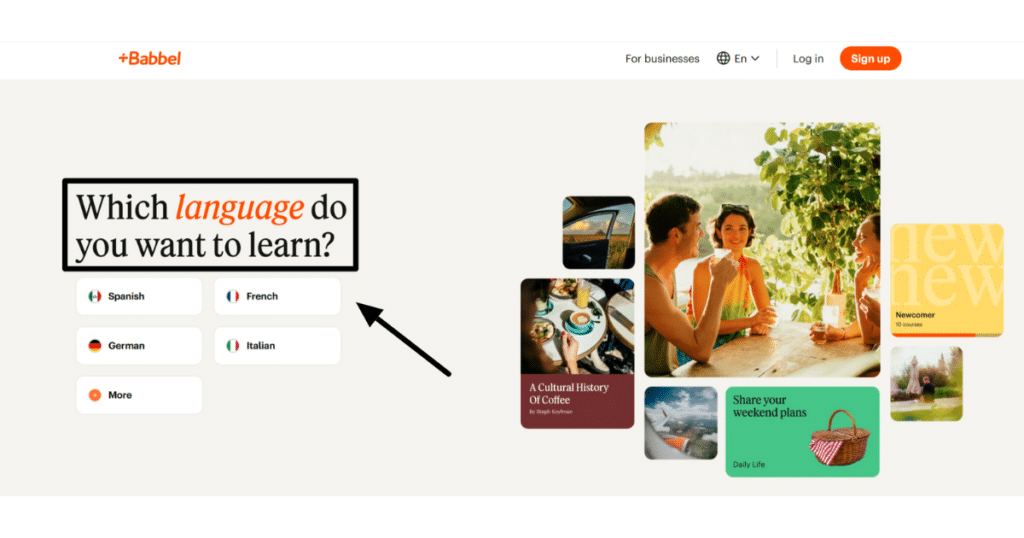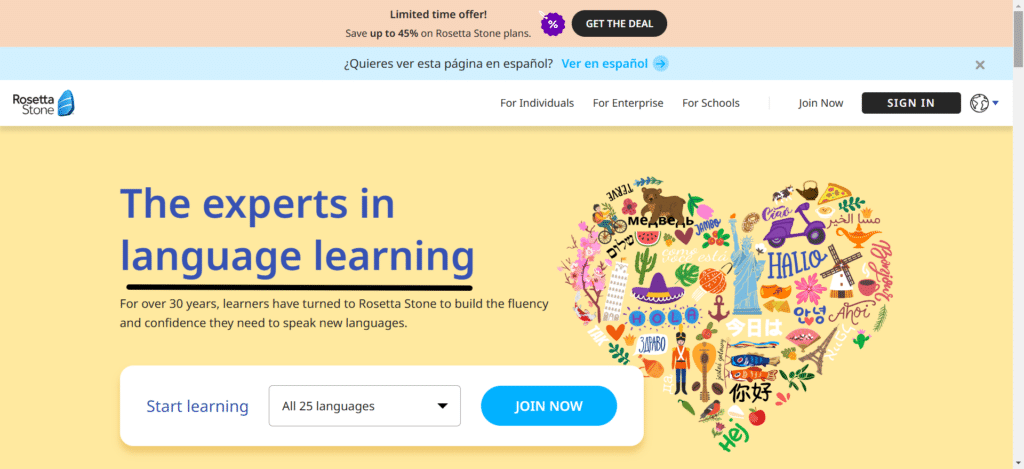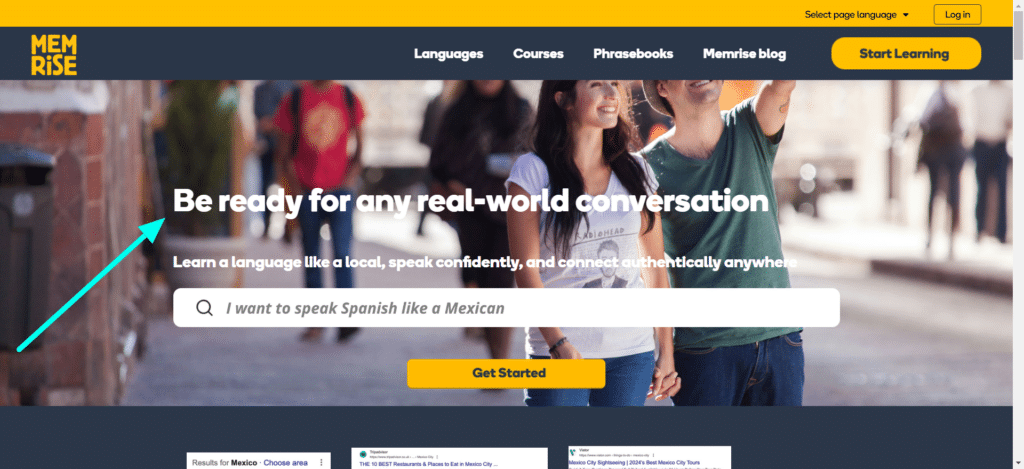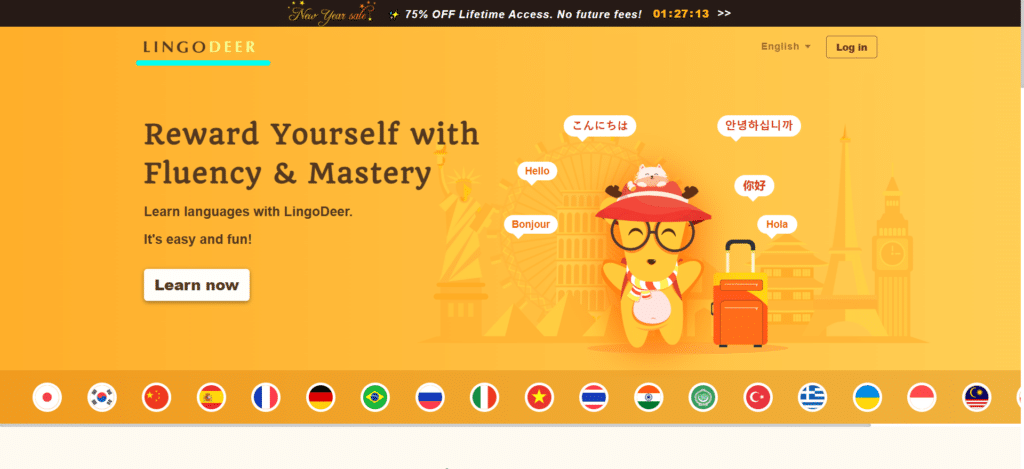
Did you know that language learning app downloads surged by 90% in 2023?
Whether you’re planning your next international adventure or boosting your career prospects, I’ve tested dozens of language learning apps to help you make the right choice.
In this article, we will examine 7 of the best language-learning apps available today. Let’s get started!
What are the Best Language Learning apps?
Here are my top picks for the best language-learning apps for 2025
1. Babbel
Best overall Language learning app

Babbel helps you learn a new language by focusing on real conversations. Instead of just memorizing words, you practice phrases you’ll actually use in daily life.
The lessons, created by language experts, prepare you for real-world situations—especially in professional settings. Plus, Babbel’s review system helps you remember what you’ve learned by bringing back key lessons at the right time.
If you’re learning for work, Babbel’s business courses cover important skills like giving presentations and talking with clients. You’ll also get cultural tips to help you avoid common mistakes when working with people from different countries.
After testing multiple language apps, Babbel’s approach to grammar explanation stands out for its clarity.
During my three months of learning French, I liked how grammar was taught in a natural way, not as separate rules. It was easier to understand because it was part of real sentences and conversations.
The review system deserves special mention. It seems to know exactly when I’m about to forget something and prompts review at just the right moment.
The speech recognition technology isn’t as refined as Rosetta Stone’s, but it’s still helpful for basic pronunciation checks. Their Customer service was responsive when I encountered a billing issue, resolving it within hours.
See my complete Babbel review
Key Features:
- A progressive curriculum designed for each language
- 10-15 minute bite-sized lessons
- Review sessions using spaced repetition
- 14 languages available (including Spanish, French, German, and Italian)
- Specialized business courses for some languages
- Speech recognition for pronunciation practice
- Sync across devices
- Offline mode for downloaded lessons
Pros:
- Cultural context integrated into lessons
- Real-life scenarios and dialogues
- Clear grammar explanations
- High-quality audio from native speakers
- Regular review sessions to reinforce learning
- Available on multiple platforms
Cons:
- Fewer gamification elements compared to competitors
- No language exchange community
- Limited free content (primarily subscription-based)
2. Rosetta stone
Best for: People who are serious about learning and can invest time daily

Rosetta Stone is one of the best-known names in digital language learning—and for good reason.
It uses an immersion-based approach, which means you learn a new language the same way you learned your first one: by seeing, hearing, and practising it naturally.
One of its standout features is TruAccent™, a speech recognition tool that gives you instant feedback on your pronunciation.
This is especially helpful if you need to speak clearly in a professional setting.
What makes Rosetta Stone even more helpful for professionals is its business-focused content.
It includes special vocabulary lessons for the healthcare, technology, and finance industries.
The lessons start with simple phrases and gradually build up to full conversations, helping you feel confident when speaking in international business settings.
As a college student learning Spanish, I spent three months using Rosetta Stone.
The first week felt like being thrown into the deep end – there was no English anywhere! But this actually helped me think in Spanish instead of just translating.
The speech recognition was my favourite part. It caught my pronunciation mistakes with Spanish ‘r’ sounds that even my study group partners missed.
One thing to note: I only tested the basic version, so I can’t speak to the advanced features. But for building a solid foundation in Spanish, it definitely helped me improve my grades in my university language course.
Key Feautures :
- Interactive picture-based learning system
- Complete immersion in target language
- Over 25 languages available
- TruAccent™ speech recognition technology
- Live tutoring sessions available
- Mobile and desktop compatibility
- Downloadable lessons for offline learning
Pros:
- Thorough vocabulary building
- Consistent quality across languages
- Strong focus on pronunciation
- Advanced speech recognition technology
- Live tutoring options available
- Mobile games and activities Cultural learning elements
Cons:
- Can be repetitive and mechanical
- Limited free trial period
- Separate charges for tutoring sessions
- Can be time-consuming to progress
3. Memrise
Best for: Travel lovers who want to learn everyday phrases

Memrise started as a community-driven platform where users could create and share courses but it has evolved into a structured language learning app with official courses.
It’s known for its unique approach combining cognitive science and gamification, particularly its “mem” system – memorable, often humorous phrases or images that help users remember vocabulary.
The platform emphasizes learning through native speaker videos (called “Learning with Locals”) and spaced repetition algorithms.
Their video clips of native speakers using words in context helped me grasp nuances that textbooks never captured.
Comparing it to traditional flashcard apps, Memrise’s approach feels more engaging and natural.
However, I noticed the user-generated content quality varies significantly – sticking to official course content provided the most reliable learning experience.
Key Features:
- Mems- User-created mnemonics and memory aids that make vocabulary sticky
- Learning with Locals – Short video clips of native speakers using words and phrases in real contexts, showing different accents and speaking styles
- Grammar Explanations – Contextual grammar tips integrated into lessons
- Pronunciation Practice – Voice recording features to compare your pronunciation with natives
Pros:
- Engaging, game-like learning experience
- Effective mnemonic techniques for vocabulary retention
- Real native speaker videos providing authentic language exposure
- Strong community features and user-generated content
- Works well for learning vocabulary and basic phrases
- More affordable than many competitors
Cons:
- Some users find the gamification elements distracting
- Premium features are required for full functionality
- Main focus is on vocabulary – less emphasis on conversation skills
4. Mondly
Best for: visual learners

Mondly combines traditional language learning methods with modern AR technology and chatbot conversations.
It stands out for offering a wide range of language combinations (rather than just learning from English) and its focus on practical daily conversations.
The app emphasizes speaking practice and uses gamification elements to keep users engaged, while incorporating VR/AR technology to create immersive learning experiences
Comparing it to other language apps I’ve tried, Mondly’s strength is its interactive elements.
The 3D visuals and audio are clearer than most apps, though I sometimes wished the speech recognition was as accurate as Rosetta Stone’s.When I had questions about some features, their support team responded within a day through the app’s chat system.
Key features:
- AI-powered chatbot that lets you practice realistic conversations with speech recognition
- Augmented reality lessons with virtual teachers in your physical space
- Daily bite-sized lessons that build progressively on previous content
- Detailed progress tracking with learning streaks and vocabulary statistics
- Learn any available language from any other language, not just English
- Family-friendly content with multi-user packages for group learning
Pros:
- A wide variety of language combinations are available
- Strong focus on speaking and pronunciation
- Innovative use of AR/VR technology
- Clear progress tracking and statistics
- Good for learning basic travel phrases
Cons:
- AR features don’t work on all devices
- Chatbot conversations can feel artificial and limited
- Limited community features and interaction with real speakers
5. Busuu
Best for: Students who need proof of their language level

Busuu differentiates itself through its unique social learning approach .
The platform combines structured language courses with peer-to-peer learning, where users can get feedback from native speakers. It focuses on practical conversation skills .
The platform provides a comprehensive learning experience that bridges the gap between app-based learning and traditional language exchange.
I mostly use it while waiting for my laundry to finish or during those long cafeteria lines. Quick 10-minute sessions add up surprisingly fast. Though let me be honest – sometimes those native speaker corrections take a while if you’re practicing at odd hours.
Pro tip: Submit your writing exercises during European daytime for faster feedback!
Key Features:
- Direct feedback from native speakers through the language exchange community
- Offline mode with downloadable lessons for on-the-go learning
- Personalized study plans based on your goals and schedule
- AI-powered vocabulary and grammar review system
Pros:
- High-quality grammar explanations
- Strong community aspect with native speaker interactions
- Personalized study planning
Cons:
- Limited language options compared to competitors
- Most valuable features require a premium subscription
- Some languages have less content than others
6. Drops:
Best for: Learners who can only study for 5-10 minutes

Drops take a unique approach to language learning by focusing exclusively on vocabulary through visual association and quick 5-minute sessions.
The app stands out for its minimalist design and visually driven learning method, completely avoiding traditional text-based explanations.
It’s designed to supplement other language learning methods rather than a complete solution, emphasizing quick daily practice sessions and visual memory techniques.
Its clean, minimalist design sets it apart from other vocabulary apps. Unlike the busy interfaces of some other apps, Drops’ simple illustrations helped me focus purely on learning.
A tip from my experience: the app works best when used consistently for short periods rather than long cram sessions.
The swipe-based interface is surprisingly addictive. It’s much more satisfying than traditional flashcards—each correct swipe gives subtle vibration feedback that makes the vocabulary review feel almost like a mobile game.
Key features:
- 5-minute learning sessions with strict time limits to prevent overwhelm
- Swipe-based exercises and unique tactile interface design
- Scripts feature for learning writing systems (like Korean Hangul or Japanese Kana)
- Multiple specialized vocabulary categories (business, technology, sports)
- Spaced repetition system for vocabulary review
Pros:
- Beautiful, clean interface design
- Effective for basic vocabulary acquisition
- Short, manageable learning sessions Large selection of languages (50+) Engaging swipe-and-tap gameplay mechanics Good for visual learners
Cons:
- Some users find the 5-minute time limit restrictive.
- Focuses solely on individual words, limited phrases
- Limited explanation of word usage/context
7. Lingodeer
Best for: Learners learning Asian languages

LingoDeer was initially created for Asian languages (Japanese, Korean, Chinese) but has since expanded to include European languages.
It distinguishes itself through structured, grammar-focused lessons and clear explanations for serious learners.
The app is particularly known for its thorough approach to teaching complex writing systems and grammar patterns of East Asian languages, with a learning path that builds fundamentals before advancing to more complex concepts.
The app’s audio quality for pronunciation is notably clearer than other Asian language learning apps I’ve tried.
Key Features:
- Comprehensive grammar explanations with native language support
- Structured learning path that builds systematically from basics
- Detailed breakdown of writing systems for Asian languages
- Interactive story lessons with natural dialogues
- Customizable flashcard review system
- Offline learning mode with downloadable lessons
Pros:
- Excellent for Asian languages (particularly Japanese, Korean, Chinese)
- Clear, thorough grammar explanations
- Well-structured learning progression
- High-quality audio from native speakers
- Strong focus on proper pronunciation
- Effective writing system instruction
- Good mix of exercises and practice types
- More academic approach than most apps
Cons:
- More expensive than many competitors
- Less engaging gamification elements
- Can feel dense and academic for casual learners
- European language courses not as developed as Asian ones
What are the Benefits of Using Language Learning Apps?
These apps make learning feel personal. They adjust to your speed, help you practice where you need it most, and use AI to shape your experience.
You can also track your progress with built-in tools. Fun features like streak counters and achievement badges keep you motivated, making learning more exciting!
Many apps also include social features, letting you connect with native speakers and fellow learners. This adds a practical, human element to digital learning that traditional textbooks can’t match.
How I Evaluated these apps?
To test and review language learning apps properly, I followed a clear and organized process. I used many key factors to make fair comparisons. I tested each app with different languages to see how well it teaches, how much content it offers, and how easy it is to use.
I checked how simple the platform feels, compared pricing to features, and tried learning tools like spaced repetition and pronunciation feedback.
I also paid close attention to progress tracking and offline use since these features make a big difference in daily learning. Lastly, I looked at community features and support to see how helpful they really are.
Final Thoughts :
Language learning apps have really changed the way we learn new languages, making education more accessible and engaging than ever before.
These apps offer incredible flexibility, letting you learn at your own pace while being surprisingly cost-effective compared to traditional classes.
Ready to start your language learning journey? Pick an app that speaks to you, and watch your language skills grow!
FAQs
How long does it take to learn a language using these apps?
Learning time varies greatly depending on your target language, prior experience, and study consistency. According to CEFR standards , 6-12 months for basic conversational fluency with 15-30 minutes of daily practice.
Are free versions of language learning apps worth it?
Free versions can be great for beginners and casual learners. However, they typically limit access to advanced features and content, making them better as supplementary tools or for testing the waters.
Which apps are best for specific languages (e.g., Chinese, Arabic)?
LingoDeer excels for Asian languages like Chinese, Japanese, and Korean with specialized writing system instruction. For Arabic, Busuu and Rosetta Stone offer strong programs.
Can I really become fluent using just an app?
Apps alone typically can’t lead to true fluency—they’re best used as part of a broader learning strategy. For the best results, check out our complete guide on how to learn a language effectively and combine these apps with conversation practice, immersion activities, and real-world language use.”
